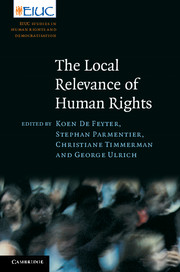Book contents
- Frontmatter
- Contents
- Contributors
- Series editors' preface
- Preface
- Abbreviations
- 1 Introduction: reconsidering human rights from below
- 2 Sites of rights resistance
- 3 Freedom from want revisited from a local perspective: evolution and challenges ahead
- 4 Relevance of human rights in the glocal space of politics: how to enlarge democratic practice beyond state boundaries and build up a peaceful world order
- 5 The local relevance of human rights: a methodological approach
- 6 Ensuring compliance with decisions by international and regional human rights bodies: the case of the European Committee for the Prevention of Torture
- 7 Building rights-based health movements: lessons from the Peruvian experience
- 8 Defining human rights when economic interests are high: the case of the western Shoshone
- 9 Struggling to localise human rights: the experience of indigenous peoples in Chile
- 10 Enforcing environmental rights under Nigeria's 1999 Constitution: the localisation of human rights in the Niger Delta region
- 11 Conflict resolution through cultural rights and cultural wrongs: the Kosovo example
- 12 Epilogue: widening the perspective on the local relevance of human rights
- Index
- References
8 - Defining human rights when economic interests are high: the case of the western Shoshone
Published online by Cambridge University Press: 07 October 2011
- Frontmatter
- Contents
- Contributors
- Series editors' preface
- Preface
- Abbreviations
- 1 Introduction: reconsidering human rights from below
- 2 Sites of rights resistance
- 3 Freedom from want revisited from a local perspective: evolution and challenges ahead
- 4 Relevance of human rights in the glocal space of politics: how to enlarge democratic practice beyond state boundaries and build up a peaceful world order
- 5 The local relevance of human rights: a methodological approach
- 6 Ensuring compliance with decisions by international and regional human rights bodies: the case of the European Committee for the Prevention of Torture
- 7 Building rights-based health movements: lessons from the Peruvian experience
- 8 Defining human rights when economic interests are high: the case of the western Shoshone
- 9 Struggling to localise human rights: the experience of indigenous peoples in Chile
- 10 Enforcing environmental rights under Nigeria's 1999 Constitution: the localisation of human rights in the Niger Delta region
- 11 Conflict resolution through cultural rights and cultural wrongs: the Kosovo example
- 12 Epilogue: widening the perspective on the local relevance of human rights
- Index
- References
Summary
The struggle of the western Shoshone peoples and their recent successes both at the Inter-American Commission on Human Rights and the Committee on the Elimination of Racial Discrimination are well known. What is also fairly well known is the difficulty of implementing these legal successes to make human rights a reality at the local level. One of the major difficulties in implementation is the endemic and imbedded nature of the situation. For Native Americans, the very coming of non-indigenous peoples was based on a desire to acquire gold and wealth to be sent back to the Church and European royalty. The indigenous peoples were labelled ‘pagans’ and ‘heathens’, their rights being defined as inferior to others, in order that the economic exploitation of lands, resources and people could be done under the name of the law. The same justifications continue today. With these justifications come attempts to restrict the definition – or relevancy – of human rights to maintain the status quo in favour of economic ‘development’.
In order to understand the extent to which this discrimination is felt, one must first understand that from the perspective of someone like western Shoshone elder Carrie Dann, the struggle is essentially a struggle between two worlds, or world-views. One is that which sees the earth as being alive accompanied with a sacred responsibility to protect it, and the other which sees the earth as a resource for human consumption and use. This conflict continues to be a fundamental impediment to making human rights a reality for indigenous peoples. In fact, it is becoming common knowledge that the increase in globalisation and trade directly correlates with indigenous rights violations and resource exploitation. Indigenous communities have resisted in many forms, and within the last decades have taken the role of human rights to a new level both regionally and internationally. This has happened through indigenous peoples themselves demanding a framework of human rights which includes indigenous rights. A ‘redefining’ of sorts, from a purely individualised, state-centred definition, to one in which indigenous ways and knowledge are respected. Thus, when we discuss the local ‘relevancy’ of human rights, we must first acknowledge that for indigenous peoples that relevancy has been something demanded and defined by them, according to their traditional teachings and laws.
- Type
- Chapter
- Information
- The Local Relevance of Human Rights , pp. 208 - 239Publisher: Cambridge University PressPrint publication year: 2011

